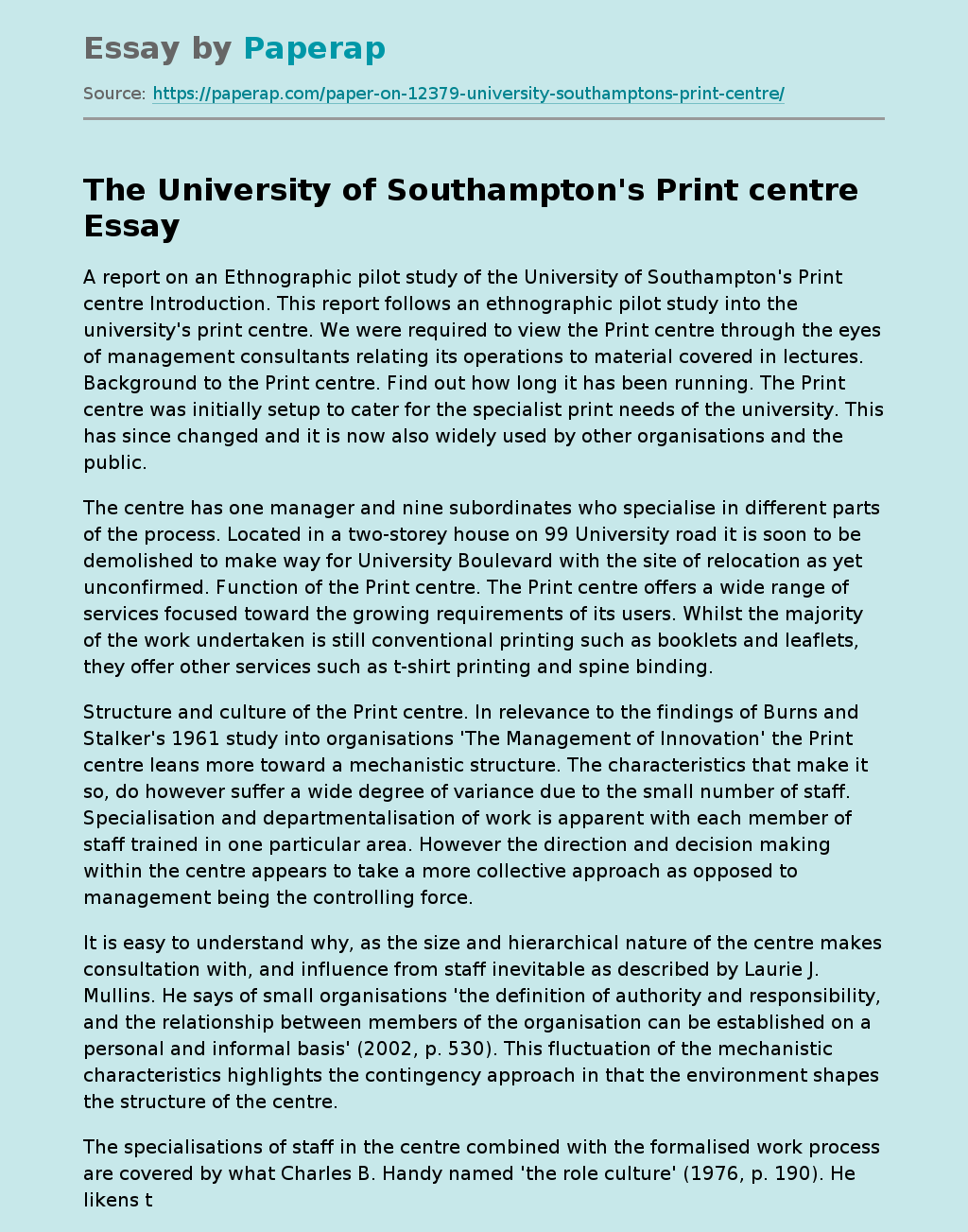Ethnographic Pilot Study of the University of Southampton’s Print Centre
This report follows an ethnographic pilot study into the university’s print centre. We were required to view the Print centre through the eyes of management consultants relating its operations to material covered in lectures. Background to the Print centre. Find out how long it has been running. The Print centre was initially setup to cater for the specialist print needs of the university. This has since changed and it is now also widely used by other organisations and the public.
The centre has one manager and nine subordinates who specialise in different parts of the process. Located in a two-storey house on 99 University road it is soon to be demolished to make way for University Boulevard with the site of relocation as yet unconfirmed. Function of the Print centre. The Print centre offers a wide range of services focused toward the growing requirements of its users. Whilst the majority of the work undertaken is still conventional printing such as booklets and leaflets, they offer other services such as t-shirt printing and spine binding.
Structure and culture of the Print centre. In relevance to the findings of Burns and Stalker’s 1961 study into organisations ‘The Management of Innovation’ the Print centre leans more toward a mechanistic structure. The characteristics that make it so, do however suffer a wide degree of variance due to the small number of staff. Specialisation and departmentalisation of work is apparent with each member of staff trained in one particular area. However the direction and decision making within the centre appears to take a more collective approach as opposed to management being the controlling force.
It is easy to understand why, as the size and hierarchical nature of the centre makes consultation with, and influence from staff inevitable as described by Laurie J. Mullins. He says of small organisations ‘the definition of authority and responsibility, and the relationship between members of the organisation can be established on a personal and informal basis’ (2002, p. 530). This fluctuation of the mechanistic characteristics highlights the contingency approach in that the environment shapes the structure of the centre.
The specialisations of staff in the centre combined with the formalised work process are covered by what Charles B. Handy named ‘the role culture’ (1976, p. 190). He likens this form of organisational culture to a Greek temple. This metaphor can be deconstructed when looking at the centre. Handy goes on to say ‘The role organisation rests its strength in its pillars, its functions or specialities’ (1976 p. 190). Indeed each pillar is represented by one of the specialist areas, each needing to be as strong the others to ensure a solid and sound building.
Holding the pillars in place is the pediment represented by the manager and her controlling influence, disseminating her authority down. Stakeholders. As the university owns and uses the Print centre the most they can be regarded as the primary stakeholder. It is for this reason that university work takes priority in busy periods. However if the balance shifted and customers from outside became the greatest users the bias would have to be addressed. The paper supplier is another important stakeholder in the organisation.
The centre relies on JIT for their paper deliveries. This situation gives the supplier indirect influence over management decisions, for example if the manager sought a cheaper supplier they would have to offer the same level of reliability and service, a risk perhaps not worth taking. As mentioned above the centre has nine staff and one manager allowing the staff to exert a degree of control over management decisions, especially when acting as a collective. Ethical issues.
British society today is heading toward a state where social responsibility, in an ethical sense, is no longer implored and congratulated but expected. The centre reflects this growing consensus by recycling of over 70% of its waste. They also offer the use of recycled paper if the user requests it and only use ‘eco-friendly’ paints. In recognising the social contract between the centre and society they lean more toward the corporate social responsibility approach than Milton Friedman’s profit maximisation beliefs.
There is a possibility that the imminent relocation may raise some ethical issues for employees. However when analysing the relocation in respect to stakeholder theory, as the centre is still to remain on campus it is difficult to see how any party will be adversely affected. How well is the Print centre managed? Following studies undertaken by the Management Charter Initiative in 1991 entitled ‘Crediting Competence’ they produced a set of four occupational standards employers thought managers should competent in. These were the ability to manage activities, resources, people and information.
The activities are well managed with the product continually meeting customers’ requirements as discussed above. In terms of resources money is well managed. The centre is supposed to be a non-profit making organisation and as such prices are set accordingly. They do however make a profit, which is reinvested in new equipment so as to remain effective. The management of the premises is perhaps not effectively or efficiently managed with the flow of work-in-progress being a disjointed one, although this can partially be put down to the location.
The relocation of the centre should provide scope for improvement here. Management of staff appears to be first rate with staff seeming happy and content in their work (the Hawthorne effect may be applicable). Information about the management of information was difficult to gather. In terms of work however all work is carried out from a job-sheet detailing the specifics of any particular job. Stocks, schedules, price quotes and other information can be accessed from a computer.
Ethnographic Pilot Study of the University of Southampton’s Print Centre. (2018, Jan 10). Retrieved from https://paperap.com/paper-on-12379-university-southamptons-print-centre/

